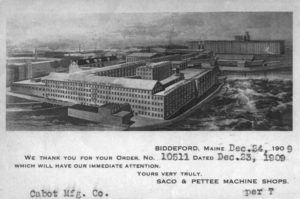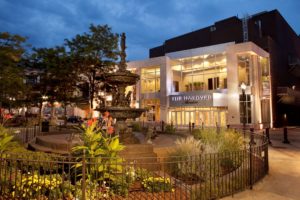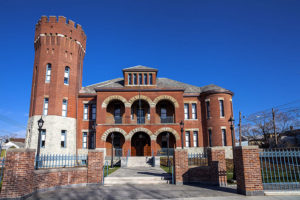On any given weekend, thousands of people travel to Worcester, Massachusetts, to see a Broadway play or headliner act at the 2,300-seat Hanover Theatre for the Performing Arts. Patrons make a day of it, stopping for dinner or visiting a nearby shop in the burgeoning arts district. What was once a boarded-up, turn-of-the century theater has become a restored architectural anchor and an economic development catalyst for downtown Worcester, attracting nearly 200,000 people a year.
The road to renewal for the award-winning Hanover Theatre and the surrounding downtown is a familiar story: long and filled with obstacles. Across the country, from derelict movie theaters to armories in disrepair, the renovation of neglected historic properties is now leading the way for urban renewal. The restorations are seeding success in struggling downtowns.
The following three examples demonstrate how an impact investor, Coastal Enterprises, Inc. (CEI) is helping to revitalize economies by using creative capital as a catalyst for sustainable development.
Each project is in a once-thriving center of commerce that was at its apex during the height of America’s Industrial Revolution.
When the mills fell silent, the jobs left, families moved to suburbia, and downtowns declined. The elegant buildings decayed, presenting pock-marked visages of broken windows and sagging structures toward blighted streets. Today these are gateway cities for a new generation of immigrants.
From Corsets to Cabaret
After a long decline for the property and surrounding neighborhood, the 113-year-old Hanover Theatre for the Performing Arts has regained its place as the entertainment jewel of downtown Worcester with world-class performances and headlining acts, including Broadway hits like Les Misérables, Cabaret and Jersey Boys. The theater was originally built as the Franklin Square Playhouse in 1904 to host touring productions of plays and musicals. The theater, called The Grand, began showing silent films and then was remodeled to make way for “talkies.”
Internationally renowned theater designer Thomas W. Lamb oversaw the renovations in 1926, which doubled seating capacity and introduced mirrored walls, marbleized columns, a grand staircase and magnificent chandelier. The theater is significant as an example of Lamb’s work, who was responsible for at least 300 theaters in North America, and is also Worcester’s oldest and finest vaudeville and motion picture theater of the “palace” theater style. The theater houses the largest theater pipe organ in New England.
During the theater’s early years, Worcester was still a booming mill town. Located in central Massachusetts, the city was a beehive of manufacturing activity from the early 1800s through the mid-1900s, churning out everything from corsets to cotton. After World War II, manufacturing in Worcester declined as companies sought cheaper alternatives elsewhere and population shifted to the suburbs. The city lost 20 percent of its population from 1950 to 1980.
After a period as a chain movie theater, the theatre sat vacant in the 1990s and early 2000s in an increasingly empty downtown. Yet, community members believed in the potential of the old gem. Local executive Edward P. Madaus formed the nonprofit Worcester Center for Performing Arts to purchase the theater and began raising donations, grants and private capital to fund the $31 million renovation. Because of the dire straits of the structure, conventional bank loans were challenging to secure. The fundraisers turned to federal programs designed exactly for this sort of project, and investors like CEI, who are experts in putting capital to work in distressed communities.
Tax-incentivized investments made through the federal Historic and New Markets Tax Credit programs, targeted at preserving historically significant properties and revitalizing economically distressed communities, provided the final pieces of the financing puzzle for the Hanover Theater project. CEI’s subsidiary, CEI Capital Management, a national leader in the New Markets program, stepped in with critical financing to attract additional investment.
The Hanover Theatre, as it is now called, held its first live performance in 2008 after a 10-year hiatus as a theater and is ranked as one of the top theaters in the world by concert publication Pollstar. In 2008, the theater won a National Trust for Historic Preservation Award for its renovation and restoration of the original 1904 building and in 2011, it was placed on the National Registry of Historic Places.
In the decade since its renovation, the Hanover Theatre has brought a vibrancy back to Worcester as host to over 140 world-class shows and performances annually and as a magnet for hundreds of thousands of visitors. The theater gives back to the community, including showcasing local artists and providing over 1,500 complimentary tickets for underserved families annually. The Hanover Theatre estimates its economic impact at over $13 million annually to the city, according to the New England Foundation for the Arts, and over $900,000 is spent annually by the theater and the city to promote Worcester as a cultural destination.
Since its re-opening, the theater has served as a linchpin for the city’s revitalization. Motivated its success, and hoping to benefit from the increased foot traffic of the theater’s patrons, the Worcester Business Development Corp. concentrated on redeveloping downtown and named the new Theatre District the focal point of those efforts. The area is now home to a community college and an innovation center/incubator space for startup entrepreneurs.
Standing Guard Over Hudson’s Citizens
A restored medieval fortress is opening its arms to welcome young and old in the heart of Hudson, New York. Built in 1898 as an armory, the 18,000-square-foot structure has been transformed into a resource for residents within a city in transition.
Hudson is a city with the proverbial nine lives. A former mill town notable as a transportation hub in the Hudson Valley, Hudson continues to reinvent itself. The city’s Amtrak station is the third busiest hub in the Northeast, with New York City 120 miles to the south. Lots of people travel through Hudson. Year-round residents struggle to stay.
Where factories once stood, art galleries, antique shops and performance venues now attract affluent New York City patrons. Property values are rising as many visitors purchase second homes or decide to relocate permanently. The poverty rate is surprising high, up to 28 percent for certain areas within Hudson, creating a disparity between “haves” and “have nots.” The armory restoration is part of an effort to address this challenge.
Eric Galloway, founder and president of the Galvan Foundation, is restoring historic buildings for social purposes in downtown Hudson. With a background in real estate and affordable housing, Galloway co-founded his foundation in 2012 with this goal. Using Rhode Island’s Newport Restoration Foundation as a model, he accumulated a critical mass of downtown historical properties for creating new homes for community groups that had been displaced by an influx of high-priced rehabs and well-heeled second home purchasers.
The Galvan Armory is a major masterpiece of that work, with its rebirth as a community hub. Designed by Isaac G. Perry and built in 1898, the Armory building has long served as a community gathering space at the corner of Fifth and State streets. The castle-like structure is one of Hudson’s most architecturally significant buildings. Prior to acquisition by the Galvan Foundation, brick-lined building had been mostly vacant and little used for decades.
The Armory is the result of a joint project between the Galvan Foundation, Hudson and CEI Capital Management, which provided access to flexible capital through the federal New Markets Tax Credits program when traditional funding was not possible.
Construction began May 2014 and involved gut renovation. The renovation balances historic elements with design to accommodate the needs of diverse groups of educational, social and health service organizations and visitors, including the Hudson Area Library, Hudson Senior Center and Perfect Ten After School program. A daycare is in the final stages of approval.
The Galvan properties, with more than $30 million in funding, 25 housing units and 33,500 square feet of commercial and community rental space in Hudson, is realizing the vision of its founder, adding more than 200 units of affordable housing stock to a community in need.
Opening in early 2016, the once blighted Hudson Armory is at the center of new energy in this downtown neighborhood. The renewal demonstrates the power of real estate to be a neighborhood catalyst for social change and urban renewal.
Second Chances in Biddeford
The renovation of the Saco-Lowell Mill in Biddeford, Maine rescued a blighted building facing demolition within the heart of the city’s historic mill district, and at the same time, provided much-needed rental housing for individuals with diverse incomes there. The environmentally sustainable project preserves industrial history central to the city’s cultural identity.
The historic repurposing of The Lofts at Saco Falls transformed the vacant 19th century factory into a thriving residential complex. The structure was built in two stages in 1842 and 1867, and for over 100 years the mill housed a machine shop where machines to weave textiles were designed and built.
The shift of textile manufacturing away from New England that affected Worcester and Hudson, also hit Biddeford hard. The towns along the Saco River in Maine had been home to some of the largest cotton milling complexes in the country. By 2015, the factory empty for decades, was facing significant deterioration. A leaking roof and broken windows had compromised structural timbers and rotted the floors.
Neglect of the property accelerated until it was purchased in 2010 by the Szanton Company, which specializes in developing mixed-income rental housing in or near downtowns. The new owner had two goals. First, to preserve a vital part of Biddeford’s industrial and cultural history in the heart of the Biddeford-Saco Mills Historical District. Second, to provide desperately needed, high-quality rental housing for diverse income groups. The apartment rent was to include heat, hot water and off-street parking. But first they needed financing for their vision.
According to Maine Preservation, Maine’s State Historic Tax Credit program has been a boon to the state, helping to finance more than a dozen redevelopment projects in rural regions and gateway cities, leveraging $350 million in private investment. CEI, the leading intermediary for Maine State Historic Tax Credits, has provided financing for the majority of those projects. The combination of affordable housing, downtown revitalization, and green building standards made The Lofts at Saco Falls project a perfect fit for CEI’s mission.
The project encountered major hurdles during the renovation. Extensive rot was discovered in the carrying beams holding up the first level. A 20th century connector building had to be demolished without damaging the 19th century buildings. And careful repair was required for the “scar tissue” on the face of the 1867 north wing. Crews had to remove the existing heating, plumbing and electrical systems, and replace all windows, including some mid-19th century openings that had been blocked for decades. The massive roof had to be removed and rebuilt. All exterior brick work was repointed.
Inside, beautiful original architectural features were retained including 11-foot ceilings, large windows and exposed carrying beams. Beyond that, a new world had to be created to serve its new inhabitants. Corridors were created inside each major wing with new one- and two-bedroom apartments on either side. A fitness room, bicycle storage room, community room with kitchen, and other amenities were added. In the attic of the 1842 wing, a hauling wheel framed with heavy timbers — believed original to the building—was discovered, as well as an enormous chest of drawers once used to store spare machine parts. Both artifacts have been placed in the community room for display.
The renovated property is located along the Biddeford RiverWalk, an urban walkway currently under development by the city. This RiverWalk sits at the crossroads of local, regional, statewide and national trails, intersecting with city trails, and connecting with Saco Bay trails, the Eastern Trail and the East Coast Greenway, which stretches from Maine to Florida.
As such, the municipality envisions the walk as a catalyst for further trail development across the city – and an economic, cultural, historic, environmental and educational engine for the region. The Lofts at Saco Falls and other mixed-use renovations provide anchors along this path.
The Lofts at Saco Falls are enjoying immediate success. As a testament to the demand, all 80 apartments inside the mill were leased by the end of the first month of availability. Watch a 3-minute video by Maine Historic Preservation embedded in this article about the renovation and reuse of the Saco-Lowell Mill.
Tax Credits Transform Communities
From Maine to Hawaii, efforts to revitalize communities, especially rural ones, are taking hold with public-private partnerships between developers and community investors like CEI. Historic Tax Credits and New Market Tax Credits play a necessary role in projects that renew downtowns and power economic development—without the credits, developers would have little incentive to focus on historic structures that have fallen into disrepair, which are often costlier to rehab than building new.
For 40 years, CEI has integrated financing, business and industry expertise and policy solutions to help grow good jobs, environmentally sustainable enterprises and shared prosperity. Nowhere is that more apparent than in these examples of historic transformations that have turned blighted neighborhoods into thriving communities.
CEI helps to grow good jobs, environmentally sustainable enterprises, and shared prosperity in Maine and in rural regions across the country by integrating financing, business and industry expertise, and policy solutions. CEI envisions a world in which communities are economically and environmentally healthy, enabling all people, especially those with low incomes, to reach their full potential.
About the Authors
 John Egan is Chief Investment Officer at Coastal Enterprises, Inc. (CEI) and is responsible for oversight of CEI’s loan and investment group and loan production.
John Egan is Chief Investment Officer at Coastal Enterprises, Inc. (CEI) and is responsible for oversight of CEI’s loan and investment group and loan production.
Under John’s leadership, CEI has expanded its renewable energy investment portfolio, and its impact in community revitalization efforts throughout Maine as a State Historic Tax Credit investor. He also leads CEI Housing as it achieves its mission to provide affordable housing in the CEI marketplace.
John has worked in housing development since 1986, mostly at community level with nonprofit agencies, as both a developer and manager of a variety of multi-family projects and special needs housing. Prior to CEI, John worked as Manager of Multi-family Programs at the Maine State Housing Authority, and developed HUD, tax credit, and supported housing projects in Alaska. John earned a B.S. in Biology from Loyola University, and a Graduate Certificate in Public Policy from the University of Maryland.
 Leah Thibault is Director of Executive Administration and Special Projects at the CEI subsidiary, CEI Capital Management LLC. As such, she delivers project management, strategic planning, and implementation support for key organizational initiatives including program advocacy efforts, funding applications and internal policy generation.
Leah Thibault is Director of Executive Administration and Special Projects at the CEI subsidiary, CEI Capital Management LLC. As such, she delivers project management, strategic planning, and implementation support for key organizational initiatives including program advocacy efforts, funding applications and internal policy generation.
Prior to joining CCML, Ms. Thibault worked in the arts as an administrator for the Theatre School at DePaul University and as a dramaturg and company manager for various theatre companies in California, Maine, and Chicago. Ms. Thibault received her B.A. from Willamette University in Salem, Oregon and has completed the HR certificate program at the University of Southern Maine.







